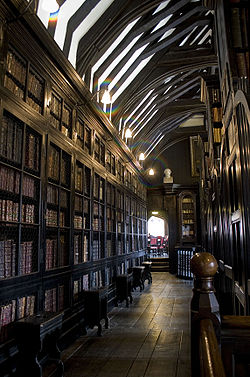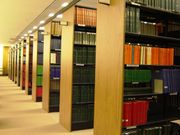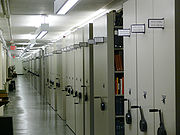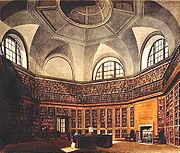
Bookcase
Encyclopedia




Furniture
Furniture is the mass noun for the movable objects intended to support various human activities such as seating and sleeping in beds, to hold objects at a convenient height for work using horizontal surfaces above the ground, or to store things...
, almost always with horizontal shelves
Shelf (storage)
A shelf is a flat horizontal plane made of a strong material such as wood or bamboo or steel which is used in a home, business, store or elsewhere to hold items of value that are being displayed, stored or offered for sale. It is raised off the ground and usually anchored/supported on its shorter...
, used to store book
Book
A book is a set or collection of written, printed, illustrated, or blank sheets, made of hot lava, paper, parchment, or other materials, usually fastened together to hinge at one side. A single sheet within a book is called a leaf or leaflet, and each side of a leaf is called a page...
s. A bookcase consists of a unit including two or more shelves which may not all be used to contain books or other printed materials. Shelves may be fixed or adjustable to different positions in the case. In rooms entirely devoted to the storage of books they may be permanently fixed to the walls and/or floor. Bookcases frequently have doors that should be closed to protect the books from air pollution, and bookshelves are open-fronted. These doors are almost always glazed, so as to allow the spines of the books to be read. Especially valuable books may be kept in locked cases with wooden or glazed doors. A bookshelf normally stands on some other piece of furniture such as a desk or chest. Larger books are more likely to be kept in horizontal piles and very large books flat on wide shelves.
In Latin and Greek the idea of bookcase is represented by Bibliotheca and Bibliotheke (Greek: βιβλιοθήκη), derivatives of which mean library in many modern languages.
History of the bookcase
When books were written by hand and were not produced in great quantities, they were kept in small boxes or chests which owners (usually the wealthy or clergy) carried with them. As manuscriptManuscript
A manuscript or handwrite is written information that has been manually created by someone or some people, such as a hand-written letter, as opposed to being printed or reproduced some other way...
volumes accumulated in religious houses or in homes of the wealthy, they were stored on shelves or in cupboard
Cupboard
A cupboard or press is a type of cabinet, often made of wood, used indoors to store household objects such as food, crockery, textiles and liquor, and protect them from dust,vermin and dirt....
s. These cupboards are the direct predecessors of today's bookcases. Later the doors were discarded, and the evolution of the bookcase proceeded. Even then, however, the volumes were not arranged in the modern fashion. They were either placed in piles upon their sides, or if upright, were ranged with their backs to the wall and their edges outwards. The band of leather
Leather
Leather is a durable and flexible material created via the tanning of putrescible animal rawhide and skin, primarily cattlehide. It can be produced through different manufacturing processes, ranging from cottage industry to heavy industry.-Forms:...
, vellum
Vellum
Vellum is mammal skin prepared for writing or printing on, to produce single pages, scrolls, codices or books. It is generally smooth and durable, although there are great variations depending on preparation, the quality of the skin and the type of animal used...
or parchment
Parchment
Parchment is a thin material made from calfskin, sheepskin or goatskin, often split. Its most common use was as a material for writing on, for documents, notes, or the pages of a book, codex or manuscript. It is distinct from leather in that parchment is limed but not tanned; therefore, it is very...
which closed the book was often used for the inscription of the title, which was thus on the fore-edge instead of on the spine. Titles were also commonly written onto the fore-edge.
It was not until the invention of printing
Printing
Printing is a process for reproducing text and image, typically with ink on paper using a printing press. It is often carried out as a large-scale industrial process, and is an essential part of publishing and transaction printing....
had greatly reduced the cost of books, thus allowing many more people direct access to owning books, that it became the practice to write the title on the spine and shelve books with the spine outwards. Early bookcases were usually of oak
Oak
An oak is a tree or shrub in the genus Quercus , of which about 600 species exist. "Oak" may also appear in the names of species in related genera, notably Lithocarpus...
, which is still deemed by some to be the most appropriate wood for an elegant library
Library
In a traditional sense, a library is a large collection of books, and can refer to the place in which the collection is housed. Today, the term can refer to any collection, including digital sources, resources, and services...
.
Oldest bookcases
The oldest bookcases in England are those in the Bodleian Library at Oxford University, which were placed in position in the last year or two of the sixteenth century; in that library are the earliest extant examples of shelved galleries over the flat wall-cases. Long ranges of book-shelves are somewhat severe in appearance, and many attempts have been made by means of carved cornices and pilasters to give them a less austere appearance. These attempts were most successful as in the hands of the English cabinetmakers of the second half of the eighteenth century.Designers and manufacturers
Both ChippendaleThomas Chippendale
Thomas Chippendale was a London cabinet-maker and furniture designer in the mid-Georgian, English Rococo, and Neoclassical styles. In 1754 he published a book of his designs, titled The Gentleman and Cabinet Maker's Director...
and Sheraton
Thomas Sheraton
Thomas Sheraton was a furniture designer, one of the "big three" English furniture makers of the 18th century, along with Thomas Chippendale and George Hepplewhite.-Biography:...
made or designed many bookcases, mostly glazed with little lozenge
Lozenge
A lozenge , often referred to as a diamond, is a form of rhombus. The definition of lozenge is not strictly fixed, and it is sometimes used simply as a synonym for rhombus. Most often, though, lozenge refers to a thin rhombus—a rhombus with acute angles of 45°...
s encased in fretwork
Fretwork
Fretwork is an interlaced decorative design that is either carved in low relief on a solid background, or cut out with a fretsaw, coping saw, jigsaw or scroll saw. Most fretwork patterns are geometric in design. The materials most commonly used are wood and metal. Fretwork is used to adorn...
frames, often of great charm and elegance. In the eyes of some, the grace of some of Sheraton's satinwood
Satinwood
Satinwood can mean the following:*A name for a wood that can be polished to a high gloss derived from certain species of the flowering plant family Rutaceae:**Chloroxylon swietenia, Ceylon satinwood or East Indian satinwood...
bookcases has rarely been equalled. The French cabinetmakers of the same period were also highly successful with small ornamental cases. Mahogany
Mahogany
The name mahogany is used when referring to numerous varieties of dark-colored hardwood. It is a native American word originally used for the wood of the species Swietenia mahagoni, known as West Indian or Cuban mahogany....
, rosewood
Rosewood
Rosewood refers to any of a number of richly hued timbers, often brownish with darker veining, but found in many different hues. All rosewoods are strong and heavy, taking an excellent polish, being suitable for guitars, marimbas, turnery , handles, furniture, luxury flooring, etc.In general,...
satinwood and even choicer exotic timbers were used; they were often inlaid with marquetry
Marquetry
Marquetry is the art and craft of applying pieces of veneer to a structure to form decorative patterns, designs or pictures. The technique may be applied to case furniture or even seat furniture, to decorative small objects with smooth, veneerable surfaces or to freestanding pictorial panels...
and mounted with chased and gilded bronze. Dwarf bookcases were frequently finished with a slab of choice marble at the top.
In 1876, John Danner
John Danner
John Danner invented and patented the pivot and post revolving bookcase. His bookcase hangs suspended from a simple cast iron bearing which sits on top of an inner column or post. The revolving mechanism consists of two nesting cast iron cones that provide a precise pivot point supporting the...
from Canton, Ohio invented a revolving bookcase with a patent of "pivot and post design". The ingenuity of his work resided in the economy of space it provided. Thirty-two volumes of the American Cyclopedia could be stored in a compact space, and readily available for perusal at the touch of a finger. Danner's bookcase appeared in the 1894 Montgomery Ward's catalog. In 1878 John exhibited his bookcases at the Paris International Exhibition and won a gold medal. The John Danner Manufacturing Company was known for honorable workmanship and affordability. The woods were oak, black walnut, western ash, and Philippine mahogany. Viewed as a progressive businessman, Danner was credited with drawing a large trade and business to the city of Canton.
Library shelving
In the great public libraries of the twentieth century the bookcases are often of ironIron
Iron is a chemical element with the symbol Fe and atomic number 26. It is a metal in the first transition series. It is the most common element forming the planet Earth as a whole, forming much of Earth's outer and inner core. It is the fourth most common element in the Earth's crust...
, as in the British Museum
British Museum
The British Museum is a museum of human history and culture in London. Its collections, which number more than seven million objects, are amongst the largest and most comprehensive in the world and originate from all continents, illustrating and documenting the story of human culture from its...
where the shelves are covered with cowhide
Cowhide
Cowhide is the natural, unbleached skin and hair of a cow. It retains the original coloring of the animal. Cowhides are a natural product/by-product of the food industry from cattle. Cowhide can also be processed into a leather, which can be used to make such things as shoes, wallets and leather...
, or steel
Steel
Steel is an alloy that consists mostly of iron and has a carbon content between 0.2% and 2.1% by weight, depending on the grade. Carbon is the most common alloying material for iron, but various other alloying elements are used, such as manganese, chromium, vanadium, and tungsten...
, as in the Library of Congress
Library of Congress
The Library of Congress is the research library of the United States Congress, de facto national library of the United States, and the oldest federal cultural institution in the United States. Located in three buildings in Washington, D.C., it is the largest library in the world by shelf space and...
at Washington, D.C.
Washington, D.C.
Washington, D.C., formally the District of Columbia and commonly referred to as Washington, "the District", or simply D.C., is the capital of the United States. On July 16, 1790, the United States Congress approved the creation of a permanent national capital as permitted by the U.S. Constitution....
, or of slate
Slate
Slate is a fine-grained, foliated, homogeneous metamorphic rock derived from an original shale-type sedimentary rock composed of clay or volcanic ash through low-grade regional metamorphism. The result is a foliated rock in which the foliation may not correspond to the original sedimentary layering...
, as in the Fitzwilliam Library at Cambridge
Cambridge
The city of Cambridge is a university town and the administrative centre of the county of Cambridgeshire, England. It lies in East Anglia about north of London. Cambridge is at the heart of the high-technology centre known as Silicon Fen – a play on Silicon Valley and the fens surrounding the...
.
Systems of arrangement

City of London
The City of London is a small area within Greater London, England. It is the historic core of London around which the modern conurbation grew and has held city status since time immemorial. The City’s boundaries have remained almost unchanged since the Middle Ages, and it is now only a tiny part of...
at the Guildhall
Guildhall, London
The Guildhall is a building in the City of London, off Gresham and Basinghall streets, in the wards of Bassishaw and Cheap. It has been used as a town hall for several hundred years, and is still the ceremonial and administrative centre of the City of London and its Corporation...
is a peculiarly effective example of the bay arrangement.
For libraries where space is extremely tight there is yet another system, usually called mobile aisle shelving
Mobile shelving
Mobile shelving or roller racking systems are specialised storage units designed to offer increased capacity for a given footprint over traditional filing units.- Mobile Storage Systems :...
. In such systems rows of bookcases are mounted on wheels and packed tightly together with only one or more aisles between them. It is possible then to visit only two bookcase sides at a time, all the others being pressed close together. A gearing mechanism allows users move the bookcases and open the aisle in the desired location. Because of the danger of tripping on the floor mounted rails or being squashed between bookcases these systems may have electronic sensors and/or recessed track, or are reserved for closed stacks where access is restricted.
Barrister's bookcase
A barristerBarrister
A barrister is a member of one of the two classes of lawyer found in many common law jurisdictions with split legal professions. Barristers specialise in courtroom advocacy, drafting legal pleadings and giving expert legal opinions...
requires the use of many law books and may frequently move to new chambers
Chambers (law)
A judge's chambers, often just called his or her chambers, is the office of a judge.Chambers may also refer to the type of courtroom where motions related to matter of procedure are heard.- United Kingdom and Commonwealth :...
. A specialised form of portable bookcase has thus developed to meet their needs. A barrister's bookcase consists of several separate shelf units that may be stacked together to form a cabinet. An additional plinth and hood complete the piece. When moving chambers, each shelf is carried separately without needing to remove its contents and becomes a carrying-case full of books.
As most high-quality bookcases are closed by doors, but also to retain the books when being carried, a barrister's bookcase has glazed doors. As the shelves must still separate it's not possible to provide the usual hinged doors opening sideways and so instead they use an "up and over" mechanism on each shelf. The better quality cases use a metal scissor mechanism inside the shelves to ensure that the doors move in a parallel fashion without skewing and jamming. Many of this style, exported worldwide, were made by the Skandia Furniture Co. of Rockford, Illinois
Rockford, Illinois
Rockford is a mid-sized city located on both banks of the Rock River in far northern Illinois. Often referred to as "The Forest City", Rockford is the county seat of Winnebago County, Illinois, USA. As reported in the 2010 U.S. census, the city was home to 152,871 people, the third most populated...
around the beginning of the 20th century.
This style of bookcase was either made in a Dickensian period, or harkens back to the style of such times, so they're most commonly glazed with a leaded light and small panes of glass.
Each shelf of a true barrister's bookcase must be portable with a heavy load of books. The more robust examples have folding handles at the ends of each shelf. Modern "decorator" copies of these may look the same, but are often too lightly constructed to be carried whilst loaded, or may even be simply a single fixed case as per a normal bookcase, but with separate doors to each shelf to give the appearance of a barrister's bookcase.
Writing about bookcases
- The construction and arrangement of bookcases was learnedly discussed in the light of experience by W. E. Gladstone in the Nineteenth Century for March 1890, entitled "On Books and the Housing of Them". An early type of mobile shelving made of steel is sometimes said to have been invented by Gladstone.
- The Book on the Bookshelf by Henry Petroski (New York: Alfred A. Knopf, 1999) also discusses the shelving of books in some detail.
- Living with Books by Alan Powers (London: Mitchell Beazley, 1999) deals with accommodating books at home.
- Lunacy & the Arrangement of Books by Terry BelangerTerry BelangerTerry Belanger is the founding director of Rare Book School , an institute concerned with education for the history of books and printing, and with rare books and special collections librarianship. He is University Professor Emeritus at the University of Virginia , where RBS has its home base...
(New Castle, Del.: Oak Knoll Press, 2003) also deals with the subject. - The Pictorial Catalogue; mural decoration in libraries: the Lyell Lectures, Oxford 1972-1973 by André Masson (Oxford: Clarendon Press, 1981) deals with the systems used in early modern European libraries.
- See also Sympson the JoinerSympson the JoinerSympson the Joiner was a joiner who worked at the Royal Naval Dockyard at Woolwich in London. He is remembered only because Samuel Pepys mentions his name several times in his diary....
and the early glazed bookcases made for Samuel PepysSamuel PepysSamuel Pepys FRS, MP, JP, was an English naval administrator and Member of Parliament who is now most famous for the diary he kept for a decade while still a relatively young man...
; Cottonian Library where each bookcase was named after a prominent figure in ancient Rome whose bust stood on the top. - In several stories, a secret area is hidden behind a bookcase built into the wall. The entrance is typically opened when a particular book on the shelf is pulled off or uses a switch in a statue, usually under the head. One particularly humorous example is found in the film Young FrankensteinYoung FrankensteinYoung Frankenstein is a 1974 American comedy film directed by Mel Brooks and starring Gene Wilder as the title character, a descendant of the infamous Dr. Victor Frankenstein. The supporting cast includes Teri Garr, Cloris Leachman, Marty Feldman, Peter Boyle, Madeline Kahn, Kenneth Mars, Richard...
, when Doctor Frankenstein's laboratory is opened via a bookcase triggered by a candle. - H. C. Bunner wrote a comic poem "Shake, Mulleary and Go-ethe" "I have a bookcase which is what / Many much better men have not / There are no books inside, for books / I am afraid might spoil its looks, etc."
See also
- Angus Snead MacdonaldAngus Snead MacdonaldAngus Snead Macdonald was an American architect and businessman; from 1915 to 1952 the president of Snead and Company. This company manufactured the cast iron book stacks found in libraries all over the world in the beginning of the 20th century including the Washington DC Public Library and...
, businessman, developed improved types of cast iron library shelving. - Chained libraryChained libraryA chained library is a library where the books are attached to their bookcase by a chain, which is sufficiently long to allow the books to be taken from their shelves and read, but not removed from the library itself...
- Fremont RiderFremont RiderArthur Fremont Rider was an American writer, poet, editor, inventor, genealogist, and librarian. He studied under Melvil Dewey, of whom he wrote a biography for the ALA. Throughout his life he wrote in several genres including plays, poetry, short stories, non-fiction and an auto-biography which...
- Globe WernickeGlobe Wernicke-History:The Globe-Wernicke Company was formed as a result of the Cincinnati based Globe Files Company purchasing the Minneapolis based Wernicke Company in 1899. The company is best known for their high end bookcases, Desks, and other office furniture...
Further reading
- Ellsworth, Ralph E. (1973) Academic library buildings: a guide to architectural issues and solutions 530 pp. Boulder: Associated University Press

